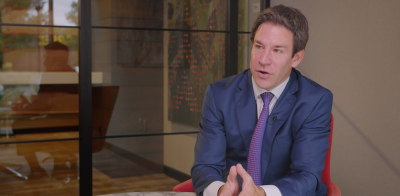The sloppy, choppy mess in markets continues and the current bear market rally is running on fumes. You are getting paid very little to take duration1 risk particularly with an inverted yield curve and 70 bps to 80 bps of recession protection has already been used up in the 10-year Treasury yield. Cash yields are up a lot, but are you really going to put all of your own or your clients’ capital in money markets and T-Bills? You do have a business to run after all and there are still investment opportunities with potentially attractive risk return profiles. So, what’s an investor to do? Continue to focus on northwest quadrant strategies on the efficient frontier2 including multi-strategy funds and Credit REITs. And if you decide to take more risk, make sure the investment has either abundant cash flows (listed business development companies or BDCs) or greater than equity-like total returns (private equity secondaries). I’ll be at the Scale Conference this week having this conversation with attendees, but I wanted to share some of my thoughts with all of you as well:
- Fortunately, due to the democratization of Alts over the past 15 years, multi-strategy investing is not limited to the uber wealthy or multibillion-dollar institutions but is also available to average investors via daily liquid 40 Act mutual fund opportunities.
- Multi-strategy investing can be confusing to many, so let’s break down some of the more attractive opportunities currently available to multi-strategy funds in the current market environment. By design, some opportunities are correlated to markets, some are not, and some are there for asymmetric downside protection. Some opportunities have positive carry, some do not, and every now and again we can find defensive positions that have little, if any, negative carry. Each has a positive return expectancy unless they are taken solely to protect capital in major market shocks. Additionally, investment/trade opportunities evolve rapidly, so being tactical and dynamic is critical to success. Ultimately, the goal is to have differentiated exposures to drive differentiated/noncorrelated returns. If every asset in your portfolio is driven by beta (to equities and real estate) or duration, it is very uncool when 60/40 is toast.
- Starting with our overarching investment theme of “Cash Flow is King,” let’s discuss three of our favorite areas to generate positive cash flow with reasonable degrees of risk:
Long interest-only (IO) cash flows backed by residential mortgages hedged with long agency pass-throughs.
The thesis is simple: Now that mortgage rates have skyrocketed and residential housing is experiencing a correction/bear market, refinance risk has plummeted. Higher mortgage rates eviscerate refinance activity and lower home prices drive higher loan to value (LTV) ratios on existing mortgages, which makes it more difficult to qualify for a refi unless additional equity in injected. Furthermore, few economically rational folks will attempt a cash-out refinancing at mortgage rates that are 2%-plus higher than their existing mortgage. IOs enjoy slow refi periods like we are in now and loathe hyper-fast refi periods like Q2 of 2020 through 2021. With relatively wide IO spreads and close to all-time wide agency pass-through spreads (special thanks to the Fed for excessive quantitative easing3 that has now become aggressive quantitative tightening4), the beauty of the current setup is we love both the cash flow and upside potential on the core asset (IOs) AND the hedge…simultaneously! This is a rare setup indeed. The icing on the cake is not only are these cash flows noncorrelated, but they are also negatively correlated to home prices, meaning the more home prices drop, the better. For more background on the now twice in a generation IO trade setup, please see this strategy note.
Long/short corporate credit
The setup in long/short credit is straightforward right now. Long high yield bonds with catalysts to drive prices higher (such as an acquisition or getting taken private) or that have no near-term refinancing risk, and short leveraged loans and weaker credits with high default risk in the next recession. To make a long story short, credit quality has deteriorated far more in leveraged loans the past ten years than in high yield bonds, so the simple pair trade makes sense. Additionally, leveraged loan income will drop to some extent in the next recession when the Fed cuts gingerly. Additionally, even though we don’t expect default rates to go to 12% in this recession as in 2000–2002, high yield default rates will probably climb to 4%–6% this cycle and remain there a while. Thus, single name short opportunities are available now when spreads are still relatively tight and prices have not dropped that much from credit deterioration (yet). You have to be nimble and trade around long and short positions (the beauty of liquid securities) and you have to be ready to hit the gas pedal when spreads get close to the wides, but these are all very achievable objectives for a robust long/short (L/S) credit manager.
Long structured credit assets like higher rated commercial mortgage-backed securities (CMBS), collateralized loan obligations (CLOs), nonagency residential mortgage-backed securities (RMBS).
Unlike IOs, the prices of these securities are correlated to equity markets, and the cash flows can in theory be impaired in a disastrous enough economic outcome. However, you can’t have all your cash flows in a multi-strategy coming from one source particularly when investment themes/trades are limited to 15% of risk and/or net asset value (NAV).
- We’ve written before about the continued compelling opportunities in CLOs where with BB rated CLOs, you may pick up more than double the yield of BB High Yield Fixed Bonds (approximately 13.3% vs. 6.6%). There is certainly more gap downside risk in BB CLO’s than a BB high yield bond index, but a multi-strategy fund that has a small exposure to BB CLOs may have the opportunity to take advantage of this yield gap.
- Over in CMBS land, you may have read something about commercial real estate being in a correction and major metro office towers losing value at a historic pace. If you haven’t, just Google it and you’ll find an incredible degree of somewhat justifiable doomsday predictions for major metro office buildings that can’t be repurposed into residential buildings, and those who conflate the real pain with the rest of commercial real estate, which is simply going through a healthy interest rate/borrowing cost driven price correction. However, the frenzy of negativity has finally driven compelling bargains in CMBS. One has to be highly selective by security, particularly regarding office concentration in the wrong geographic regions (sorry to call you out New York City, Chicago, Los Angeles and San Francisco), but some BBB CMBS bonds have the potential to be yielding somewhere between 12% and 15% right now.
- In nonagency RMBS (the small slice of the market not financed by Fannie, Freddie, Ginnie or banks), yields have climbed back up to the high single digits…certainly not as high as CLOs or CMBS, but also with less volatility.
- So, the thesis for long/short corporate credit and structured credit right now is to try to earn an attractive yield as spreads continue to widen into a recession. The beauty of high single-digit/low teen cash flows is you can absorb quite a bit of spread widening without losing money. There is always gap risk in spread product when liquidity thins out, but at these yield levels, you need to at least start legging in, provided you have other noncorrelated sources of return in a multi-strategy fund (like IOs for instance). Once spreads hit the wides, you’ll have not only a waterfall of cash flow but also substantial price appreciation as spreads tighten back in. If recession is somehow, someway avoided, then you’ll earn an income stream that is arguably superior to what is available in equity markets trading back at 19 times 2023 earnings or vanilla fixed income focused funds.
4. We’ve spent a lot of time discussing cash flow generative strategies within multi-strategy funds, so let’s now discuss a few cool ideas that do not generate cash flow.
- Factor/style/market cap equity pairs. These trades come and go in terms of which factor/style/cap make sense to go long and short. Not too long ago (although it feels like many moons) in early 2021, the best pair was short nonprofitable tech vs. long cyclicals and value. By the beginning of 2022, it was as simple as long value/short growth. By September of last year, it was short expensive defensives and long growth and cyclicals. Now, there are two factor opportunities that appear attractive:
- Long S&P 500 equal weight/short 500 S&P market cap weight, aka the S&P 500. Those of you that managed client assets through the great bear market of 2000–2002 probably remember being long equal weight was the way to go as the dot-com bubble imploded. Many of you probably boosted your career success by pursuing this exposure successfully. Since the Silicon Valley Bank (SVB) failure—as money has flooded back into mega cap tech, and Apple and Microsoft have approached 15% of the S&P 500 weighting—the spread between market cap and equal weight has expanded dramatically; particularly at a time when an anticipated recession should drive equities lower. The setup is pretty straightforward: When the recession drives earnings lower and markets drop 15%–25% from here, the spread should compress. If we’re dead wrong on our macro view and the Fed threads multiple needles, and we avoid recession and interest rates stay higher, the spread should compress. However, if technical factors or investor sentiment drives a complete replay of the 2020 and 2021 “glory of the FAANGS” (Facebook, Apple, Amazon, Netflix, Google) again, the spread will widen further and there is potential for downside.
- Short over-earners during the post-COVID inflationary period and long quality with strong earnings power in a decelerating inflation backdrop. Basically, it’s a way to play the normalization between companies that benefited from the highest inflation in over 40 years and those that were taken to the woodshed by it; this is particularly timely since inflation is obviously receding, and recession risk has escalated dramatically. It is a heck of a lot harder to increase price and volume faster to customers than when costs increased when excess savings have been run down, credit is being constrained and unemployment is going from 3.4% to 4.5%. In other businesses, you are much less likely to see your costs from snarled supply chains and energy/commodities spike again faster than revenue as nominal growth domestic product (GDP) growth cools off.
- Packaging the potential for downside protection. Bear market rallies are a terrible thing to waste, particularly if you care about protecting capital in the next downturn. Now that implied and realized volatility have collapsed back to early 2022 levels—The Chicago Board Options Exchange (CBOE) Volatility Index (VIX) briefly had a 16 handle with an 80% to 90% probability of recession over the next 12 months…go figure—defensive trade expressions are back on sale. Skilled multi-strategy managers have combed the universe of interest rate, currency and equity volatility to find low to zero negative carry opportunities that may offer protection from major market sell-offs. Here are a few examples:
- Long deep out-of-the-money S&P 500 puts vs. short less out-of-the-money S&P 500 puts in a 3 or 4 to 1 ratio. Effectively, using the premiums of the less out of the money puts you sold to fund your long-put position. Since the carry/premium extracted from the less out of-the-money puts is 3 to 4 times higher than the deep out-of-the-money puts, you can buy more of the further out-of-the-money puts than the less out-the-money puts you sold. This defensive expression isn’t perfect because in a grind lower of 5%–10%, you could lose money, as those less out-the-money puts you sold retain or gain premium while your long deep out-of-the-money puts expire worthless. But in a down 10% or greater sell-off, over a reasonably short period of time, the convexity/gamma begins to kick in and can help limit losses from spread widening in some of the cash flow generative strategies.
- Long zero premium 5% out-of-the-money barrier put option expiring in September. No premium or negative carry at inception (unlike a typical option where you start burning premium from day one at an accelerating pace as you get closer to expiration). If the S&P 500 gains 7.5%, you have to pay a 3.5% premium, which we view as unlikely and believe this bear market rally is running on fumes. If the S&P 500 drops by 10%, you have to pay a 3.5% premium, but net out a return of 1.5% as a result of the S&P falling 5% below the contracted put option strike price. If the S&P 500 does not gain 7.5% or lose 10%, it just behaves like a normal 5% out of the money put option (but without the premium), maintaining positive premiums when markets sell off below the strike price, and mitigating losses if the market rallies but stays below a 7.5% gain. If markets drop by 15% or more between now and the September expiration, the trade maximizes on our expected downside opportunity and takes advantage of the third/fourth major bear market rally of the galactic mean reversion while enhancing your portfolio’s downside protection!
We hope this gives you an even better understanding of what is beneath the hood in a select group of daily liquid multi-strategy solutions that are the ultimate expression of democratized alternatives! The time for the RIGHT Alts is STILL Now!
Investing in alternatives is different than investing in traditional investments such as stocks and bonds. Alternatives tend to be illiquid and highly specialized. In the context of alternative investments, higher returns may be accompanied by increased risk and, like any investment, the possibility of an investment loss. Investments made in alternatives may be less liquid and harder to value than investments made in large, publicly traded corporations. When building a portfolio that includes alternative investments, financial professionals and their investors should first consider an individual’s financial objectives. Investment constraints such as risk tolerance, liquidity needs and investment time horizon should be determined.




